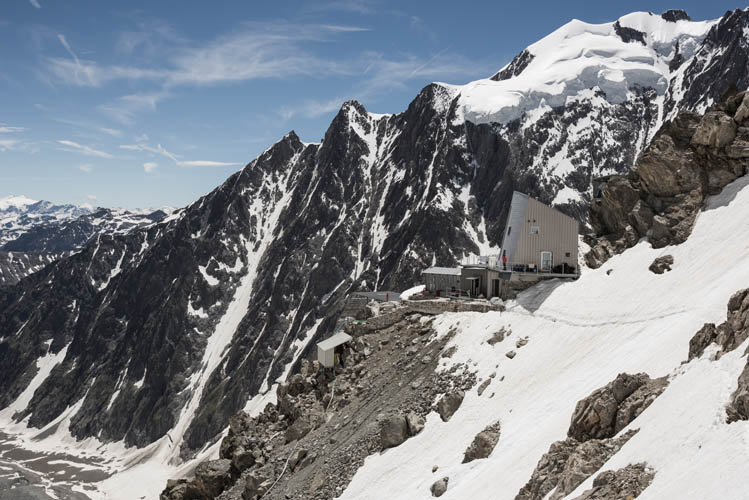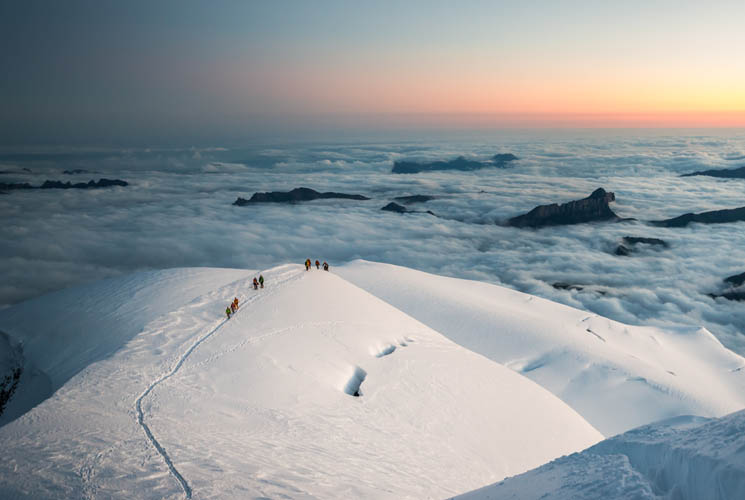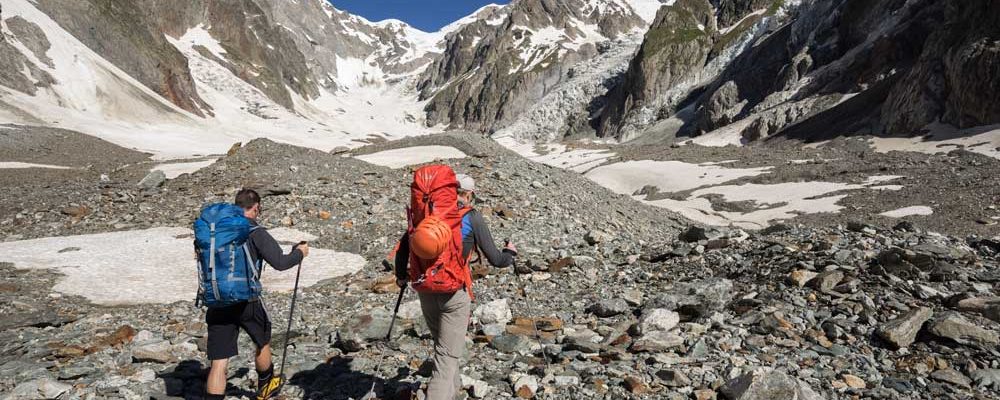For a more ‘off-the-beaten-track’ experience on Mont Blanc, the Italian Route via the Gonella Hut takes some beating, says IFMGA Guide Ben Tibbetts
Most of the Italian side of Mont Blanc is composed of wild and impressive ridges of granite and severely steep glacial terrain. However, hidden far out of sight of any road or lift access is a way called the Pope Route, or just ‘the Italian Route’, that climbs from the Glacier du Miage via the Gonella refuge to then follow the Italian/French border to the summit. It is an exceptionally beautiful route that surprisingly finds no greater technical difficulties than the easiest route on the French side. The approach hike up Val Veny and the Miage basin, though only a few hours longer than the Goûter route thankfully serves to filter out all but a trickle of mountaineers so you can enjoy the mountain itself rather than the bunfight on the other side. It was first traversed in 1890, by a team including the future Pope Pius XI, as a descent after climbing the sustained Tournette Spur on the west face of Mont Blanc.
For the many people hoping to climb Mont Blanc, the ‘normal’ routes on the French side (the Goûter and Three Monts routes) of the mountain will be the only options in mind. The route via the Goûter refuge is definitely the easiest way up the mountain, with train access to 2372m and two refuges (Tête Rousse and Goûter huts) to break up the challenge into more manageable chunks. During the summer season, however, it is usually very crowded and unfortunately some climbers are so desperate to reach the summit that they take no consideration for the safety and wellbeing of others. At the Goûter refuge a couple of years ago, while taking a coffee on descent with clients, I even had my rope pinched by a group of Russians who were later arrested by the French PGHM (high mountain police). It is unfortunate that for many it will be their only experience of alpine mountain culture, so misrepresentative of the quiet and reflective mountaineering experience that draws us back time and again. A traverse of the mountain from Italy to France climbing via the Pope Route and then quickly down either the Goûter or Three Monts route, by contrast, makes for a very fine outing.
The climb (5th July 2016)
We took a taxi through the tunnel from Chamonix to Val Veny and got dropped off at the end of the road beyond the Chalet del Miage. Having left the car just after 7am, it allowed us to arrive early at the refuge for a good lunch and siesta and avoid walking in the heat of the day on big snow slopes. We continued on foot to Combal where the view finally opens up across lakes and marshes. The eye is drawn beyond to the wild Lee Blanche basin and the Elisabetta Soldini hut at the far end of the valley. We followed the path round to the right and up onto the moraine of the Miage glacier. Though the glacier looks like a broad rocky jumble, the ice does continue underneath much further down the valley than it appears. The sun was rising fast in early morning sky but a cool breeze was flowing down from the massive glaciers above. Along the moraine were a troup of at least 20 ibex clattering around on the steep slopes, picking at the grass and licking natural salts off the rocks. They were particularly uninterested by our presence and only gave way to us on the narrow crest path as we came close upon them.
We followed the moraine up the valley until it petered out into the mountainside. We then descended down the steep rubble onto the rock-covered glacier to pick up the faintly-marked trail on the central ridge. Some of this rock and debris on the glacier must move very steadily as a few grasses and flowers were growing in places where the dust and silt of the moraine provided purchase. The rock cover gradually diminished as we moved further up the glacier and soon we were winding our way between grey crunchy ice and more and more widely dispersed patches of rocks. One at a time we leapt across the only open crevasse that blocked our path.
By now the air was warm and a large pool of green glacial melt water was almost tempting. With schoolboyish bravado handsome rewards were laid down for the first to jump in for a swim… thankfully the moment passed and we carried on up the glacier. At about 2400m we finally met the snow line. Having walked fairly slowly it was around 11am and the snow was softening in the sun. We roped up in case someone found a crevasse hiding under the snow, and headed up past the chaotic foot of the Glacier du Dome. Though the hut is on the edge of this glacier we had to carry on round the corner to find where the Gonella path leaves the main Miage glacier. A short mucky scramble took us up onto the rough path, marked by a large yellow dot on rocks. We took off the rope but kept helmets on as there was plenty of potential for rocks to trundle down from above the track as the sun began to loosen things up. The path wraps back round north-east high above the glacier crossing several steep gullies that we traversed delicately on the softening snow and then a few sections of scrambling and ladders. After the final snow slope we got onto the broad buttress of rock that leads up to the refuge. At times I have found it tricky to get off the snow and across this gap to the rock but this time, with plenty of snow remaining, it passed easily. More ladders, chains and fixed ropes took us up the buttress to reach the refuge after 1pm.

Lesser-travelled path
I was very surprised, given it was high season in mid July, that there were only a few tracks on the glacier and snow slopes to the hut. Though the hut is usually full on weekends, it is often quiet during weekdays and alongside the guardian’s family and some friends of his, we were the only ones staying in the hut. A Polish guy was squatting in the winter room below. With two other friends they had driven 17 hours from Poland only two days before, walked up to the hut with all their food and cooking equipment. They had all set off early that morning but the guy we met returned from the Piton des Italiens as he had fallen ill, unsurprising given their complete lack of acclimatisation. He then walked back down the glacier on his own, lucky to not fall into a crevasse, to arrive back at the hut about the same time as us. His friends continued on, reaching the summit late in the day and finally returned back joyful and tired 11 hours later, at midnight, after a 24-hour round trip!
We had taken a more conventional approach and had done several days acclimatisation climbing above the Torino hut before coming to the Gonella. The guardian cooked us a simple but delicious pasta dish and we all headed to bed at 3pm for an afternoon siesta. A few hours later we got up for another feed: mushroom and cheese risotto followed by cheesy mashed potato, pork and apple sauce, and a chocolate mousse to finish. We packed our bags and headed to bed at 7.30pm for another short sleep. We took breakfast at 11pm – just a few slices of bread and jam were our quota and the guardian seemed reluctant to give us much more, which marred the otherwise impeccable experience. By midnight we were off, traversing carefully across the steep and exposed snow beyond the refuge. It provided a sharp wake-up call and in 15 minutes we were down onto the Glacier du Dôme. The night air was still warm. Thankfully, despite the air temperature hovering just above zero, the heat had radiated back out of the snow as night fell and the surface was crisp and frozen firm. We moved up the glacier as two teams of three, each lost in our pools of light. Without any moonlight it was unusually dark. There is almost no light pollution on this side of Mont Blanc and I couldn’t even make out the shapes of the mountains around. If given the choice, I would travel up this route with some moonlight as it is such a spectacular and wild place to pass through.
Thankfully the track on the Glacier du Dome was already well beaten in, as it would be very hard to find a way through the maze of crevassing whilst breaking a new trail on such a dark coal miner’s night. The glacier steepens up towards the head and the route moves left onto the ridge. Though there was almost no wind on the glacier, when we popped up onto the Col des Aiguilles Grises at 2.30am a chilly westerly breeze was already gaining momentum. I usually find the hours from 2-4am the hardest to keep focused. However as I was moving up the gradually narrowing arête roped up with John, one of our clients, I was alert to every movement of the wind, of the rope, and the yawning darkness to either side of our headlamps.
From the small summit of the Piton des Italiens, the ridge becomes very narrow and exposed for a short while and I took advantage of the lack of cornice to scramble along and hold the rope from the opposite side of the ridge to the delicate tracks John was on. A lot of people who come to climb Mont Blanc are fairly goal-focused, and for John this was a stepping stone on his quest to climb Everest. It was a pleasure to be able to show him the wilder side of the mountain.
We were five hours into the climb and had yet to see another climber or any other lights but those of the towns several kilometres below us in the valley floor. The ridge soon broadens and we lengthened the rope back out to pass up the ridge over a few crevasses and then round the side of the Dôme du Gôuter to the col beyond. We reached the track of the normal (Gôuter) route from the French side at around 4am and were surprised to find we were ahead of everybody coming from the Gôuter refuge. The night sky was still largely clear except a few whispy high clouds developing. The temperatures had dropped significantly with the altitude and the wind was still building gently. We crawled into the Vallot hut to find, as usual, a bunch of hobo people bivouacing (though it is designated for emergency use only) and heaps of trash everywhere. An unpleasant wake-up call that signalled our meeting with the ‘normal route’ and amongst these numbers unfortunately comes the lowest common denominator of mountain user.

On to the summit
After a break at the Vallot we clambered back out in to the frigid wind to find the pre-dawn flow of troops well advanced. The Bosses Ridge leading to the summit was in great condition with no ice showing at all. As the sun first peeked over the horizon beside Mont Maudit I rushed around trying to photograph the climbers and the landscape. I interspersed short sprints with minutes of hyperventilating in a heap. When I sat down briefly to change to a telephoto lens, I had great difficulty avoiding filling the camera with spindrift. As we climbed slowly up the snowy ridge the warm light spread across the sky, and yet very soon the sun began to be obscured by high clouds. Even having climbed up there countless times I am always slightly surprised how much hard work it requires to get up Mont Blanc, and yet also how far people can push themselves to fulfill their ambitions.
Within minutes of arriving on the summit at 7am, the swirling cumulus clouds that had been building up over the Dome du Goûter spilled up around us. We turned around after only a short rest and on the descent we kept moving steadily down through the mist and cloud, past many other teams and with weary heads and legs down to the Goûter refuge. Our early start had been fortuitous, as most teams were turning around due to the approaching weather. We had promised ourselves a break at the Goûter and a cup of coffee, but with the clouds becoming denser by the minute and static electricity building in the air we pressed on down the ridge below. However almost as quickly as they had materialised the clouds began to disperse on the lower flanks of the mountain. We scrambled down the rocky ridge and crossed the Grand Couloir just before the sun hit. I never enjoy this mortal passage and even early in the morning a few stones were whizzing down. Once crossed we were finally able to relax and stopped for a quick lunch at the Tête Rousses hut before continuing on down the mountain, glissading on patches of mushy snow most of the way to the train at Nid d’Aigle and thus to the valley floor.
Words and images: Ben Tibbets
Feeling peaky?
BMC Travel insurance comes with £10 million emergency medical cover: Knock yourself out.
After Alpine & Ski insurance? We’ve got a great deal to keep you covered: 25% off all annual multi-trip policies in Europe, which works out at £141 for 12-months cover.

Years of experience
We’ve been insuring adventurers like you for over 30 years. That’s why all of our policies come with:
- 24-hour emergency assistance helpline
- £10 million emergency medical cover
- £100,000 search, rescue and recovery cover
- £10,000 personal accident cover
- £5,000 cancellation cover
- £2,500 baggage cover
- No age loading until you’re 70
WATCH: BMC Insurance: built for the mountains
Want to know more? READ: 5 reasons why you need BMC Travel Insurance
*Policy details: £141.80 for annual European Alpine and Ski cover up to age 69. For policies purchased between 14 May and 31 August 2018.






